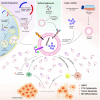Exosome-based immunotherapy as an innovative therapeutic approach in melanoma
- PMID: 39482766
- PMCID: PMC11526674
- DOI: 10.1186/s12964-024-01906-1
Exosome-based immunotherapy as an innovative therapeutic approach in melanoma
Abstract
The malignant form of melanoma is one of the deadliest human cancers that accounts for almost all of the skin tumor-related fatalities in its later stages. Achieving an exhaustive understanding of reliable cancer-specific markers and molecular pathways can provide numerous practical techniques and direct the way toward the development of rational curative medicines to increase the lifespan of patients. Immunotherapy has significantly enhanced the treatment of metastatic and late-stage melanoma, resulting in an incredible increase in positive responses to therapy. Despite the increasing occurrence of melanoma, the median survival rate for patients with advanced, inoperable terminal disease has increased from around six months to almost six years. The current knowledge of the tumor microenvironment (TME) and its interaction with the immune system has resulted in the swift growth of innovative immunotherapy treatments. Exosomes are small extracellular vesicles (EVs), ranging from 30 to 150 nm in size, that the majority of cells released them. Exosomes possess natural advantages such as high compatibility with living organisms and low potential for causing immune reactions, making them practical for delivering therapeutic agents like chemotherapy drugs, nucleic acids, and proteins. This review highlights recent advancements in using exosomes as an approach to providing medications for the treatment of melanoma.
Keywords: Cancer vaccine; Drug delivery; Drug resistance; Exosome therapy; Melanoma.
© 2024. The Author(s).
Conflict of interest statement
The authors declare no competing interests.
Figures


Similar articles
-
Exosomes as key mediators in immune and cancer cell interactions: insights in melanoma progression and therapy.Arch Dermatol Res. 2025 Apr 19;317(1):729. doi: 10.1007/s00403-025-04237-4. Arch Dermatol Res. 2025. PMID: 40252131 Review.
-
Melanoma-derived exosomes: Versatile extracellular vesicles for diagnosis, metastasis, immune modulation, and treatment of melanoma.Int Immunopharmacol. 2022 Dec;113(Pt A):109320. doi: 10.1016/j.intimp.2022.109320. Epub 2022 Oct 20. Int Immunopharmacol. 2022. PMID: 36274482 Review.
-
Immunomodulatory effects of immune cell-derived extracellular vesicles in melanoma.Front Immunol. 2024 Sep 26;15:1442573. doi: 10.3389/fimmu.2024.1442573. eCollection 2024. Front Immunol. 2024. PMID: 39391320 Free PMC article. Review.
-
Future perspectives in melanoma research : Meeting report from the "Melanoma Bridge". Napoli, December 1st-4th 2015.J Transl Med. 2016 Nov 15;14(1):313. doi: 10.1186/s12967-016-1070-y. J Transl Med. 2016. PMID: 27846884 Free PMC article.
-
Exosomes, their sources, and possible uses in cancer therapy in the era of personalized medicine.J Cancer Res Clin Oncol. 2024 Dec 26;151(1):16. doi: 10.1007/s00432-024-06066-w. J Cancer Res Clin Oncol. 2024. PMID: 39724442 Free PMC article. Review.
Cited by
-
Emerging role of exosomes in cancer therapy: progress and challenges.Mol Cancer. 2025 Jan 13;24(1):13. doi: 10.1186/s12943-024-02215-4. Mol Cancer. 2025. PMID: 39806451 Free PMC article. Review.
-
Chemotherapy efficacy in advanced melanoma patients after failure of immune checkpoint and BRAF/MEK inhibitors.Contemp Oncol (Pozn). 2025;29(2):165-170. doi: 10.5114/wo.2025.150451. Epub 2025 May 9. Contemp Oncol (Pozn). 2025. PMID: 40620891 Free PMC article.
-
Exosomes as key mediators in immune and cancer cell interactions: insights in melanoma progression and therapy.Arch Dermatol Res. 2025 Apr 19;317(1):729. doi: 10.1007/s00403-025-04237-4. Arch Dermatol Res. 2025. PMID: 40252131 Review.
-
Immune modulation by melanoma-derived exosomes: suppression of BALB/c mice splenic cell proliferation, induction of apoptosis, and cell cycle arrest.Mol Biol Rep. 2025 Aug 6;52(1):794. doi: 10.1007/s11033-025-10899-0. Mol Biol Rep. 2025. PMID: 40767919
-
Harnessing engineered extracellular vesicles for enhanced therapeutic efficacy: advancements in cancer immunotherapy.J Exp Clin Cancer Res. 2025 May 2;44(1):138. doi: 10.1186/s13046-025-03403-w. J Exp Clin Cancer Res. 2025. PMID: 40317075 Free PMC article. Review.
References
-
- Sung H, Ferlay J, Siegel RL, Laversanne M, Soerjomataram I, Jemal A, et al. Global cancer statistics 2020: GLOBOCAN estimates of incidence and mortality worldwide for 36 cancers in 185 countries. Cancer J Clin. 2021;71(3):209–49. - PubMed
-
- Boussios S, Rassy E, Samartzis E, Moschetta M, Sheriff M, Pérez-Fidalgo JA, et al. Melanoma of unknown primary: new perspectives for an old story. Crit Rev Oncol/Hematol. 2021;158:103208. - PubMed
Publication types
MeSH terms
LinkOut - more resources
Full Text Sources
Medical

